As always, life is a little crazy between running the office, doing presentations and advocating for parent involvement and our students of color on Capitol Hill. I think I have been invited to be on every board known to mankind. Well, not every board, but it feels like it…
Being in the classroom, it’s easy to become insulated, to feel like you are on an island, doing so much on your own. Am I the only one doing this? Is there someone with whom I can partner to some extent? Although I don’t enjoy board meetings, there is something about getting a number of different kinds of folks around the table from different industries with different backgrounds talking about the same issues. Suddenly it is apparent that you are not alone. There are other people out there with the same goals. We just didn’t know about one another.
Somehow we need to figure out a way to gather like-minded educators in a regular organized way to allow them to share ideas, to commiserate, to dream. This process should not be afforded merely to those who have left the classroom and now have “time” to chat. The conversations I was involved in today should have been happening with actual teachers around the table, people who are experiencing the challenges of trying to deliver curriculum while developing relationships with students struggling to find themselves in a complex world.
I know I realized this months ago, but something about today’s meeting struck me distinctly – so many of the decisions being made in our state (and likely around the nation) are happening in rooms full of middle-aged white men and women. I am not saying that these people do not know what they are talking about or that they should not be part of the conversation, but I am becoming more and more convinced that if our system is going to bring the changes we really need, the tables at board meetings MUST represent not only the diversity of the students being served by our system, but also with a diversity of perspective, which can only come by having young, middle-aged and experienced educators of all ethnic and socio-economic backgrounds at the table at once.
skip to main |
skip to sidebar
A blog by the staff from the Center for the Improvement of Student Learning at OSPI. Visit us at www.yourlearningcenter.org
About CISL
- Center for the Improvement of Student Learning
- Olympia, WA, United States
- Visit www.yourlearningcenter.org to learn about CISL.
.jpg)